|
Report from
Europe
EU plywood imports highest since financial crises
EU28 imports of plywood increased 12% to 3.7 million
cu.m in 2014, the highest level since before the financial
crises. Import value also increased 12% to €1.35 billion.
The rise was driven mainly by improved consumption in
several European markets, notably the UK.
Another key factor was an increase in supply of Russian
birch plywood combined with a sharp fall in the value of
the Russian rouble on foreign exchange markets which
increased competitiveness of imported Russian product.
Another notable feature of the European plywood market
in 2014 were signs that rising concern for the
environmental and technical performance of plywood is
having a more a significant impact on trade.
In 2014, the EU imported 2.4 million cu.m of hardwood
plywood with value of €986 million, up 11% and 13%
respectively compared to the previous year. EU imports of
this commodity were at their highest level since 2008
(Chart 1).
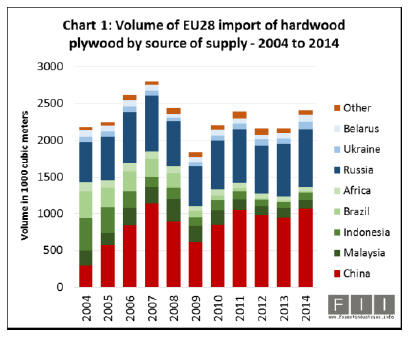
Compared to previous years, in 2014 the EU market for
hardwood plywood was less volatile and changes in
supply sources and overall market share were relatively
minor (Chart 2). EU28 imports of hardwood plywood
from China increased 14% to 1.07 million cu.m in 2014.
However China‟s share of total EU28 imports increased
only slightly from 43% in 2013 to 44% in 2014. Imports
from Russia increased 10% to 785,000 cu.m in 2014 and
Russia‟s share of total imports remained stable at 33%.

﹛
Share of EU28 imports of hardwood plywood from
tropical countries fell from 14% in 2013 to 12% in 2014.
The decline in share was mainly due to a 15% fall in
imports from Malaysia to 115,000 cu.m in 2014.
Imports from African countries also declined by 3% to
59,000 cu.m. In terms of tropical hardwood market share,
these declines in imports were only partly offset by
increases from Indonesia (+24% to 105,000 cu.m) and
Brazil (+61% to 20,000 cu.m).
Sharp increase in imports of Chinese MLH plywood
The increase in EU28 imports of Chinese plywood in 2014
was driven mainly by rising demand for plywood faced
with ※other hardwood§. Most consists of Mixed Light
Hardwood (MLH) plywood faced with eucalyptus and
poplar, with a smaller amount of birch, other temperate
hardwood and lesser known tropical species.
EU imports of Chinese softwood plywood and plywood
identified as faced with tropical hardwood continued to
decline last year (Chart 3).
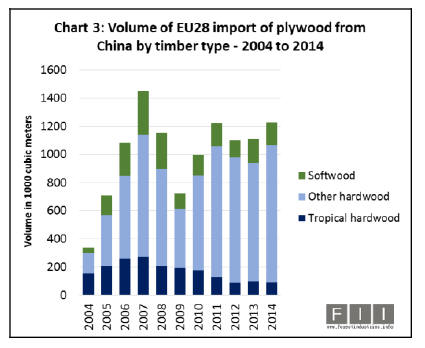
During 2014, there were significant gains in imports of
Chinese hardwood plywood into the UK, Belgium,
Poland, Netherlands, Bulgaria and Romania. Imports into
Germany declined while imports to France were stable
(Chart 4).
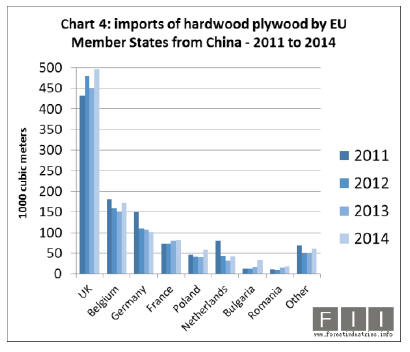
EU imports of MLH plywood from China benefited from
the relatively stable supply situation during 2014 with
delivery times into Europe of no more than around 4 to 5
weeks.
The decline in imports into Germany is partly due to the
recent practice by German customs to record some
plywood imports from China as LVL thereby pushing
them into a higher tax bracket.
Speculation that implementation of EU Timber Regulation
(EUTR) might lead to loss of market share for Chinese
plywood in the EU has yet to be realised. It was assumed
that obtaining reliable legality documentation might be
difficult for Chinese plywood due to complex supply
chains and dependence on imported face veneers.
Rather than shifting to alternative supply countries in
response to EUTR, EU operators have increased purchases
of Chinese plywood faced with plantation grown domestic
hardwoods perceived to be lower risk.
Decline in UK imports of Malaysian plywood
The fall in EU trade in Malaysian plywood was driven by
a large decrease in imports by the UK, by far the largest
European market for this commodity (Chart 5).
Imports by the Netherlands, the second largest market,
increased slightly while imports by other EU countries
were relatively stable.
The decline in UK imports may be partly explained by
Malaysia losing GSP preferential tariff status from 1
January 2014. This led to a sharp increase in UK imports
from Malaysia in the closing months of 2013 followed by
a slowdown in 2014.

Imports from Malaysia also clearly lost competitiveness
relative to China and Indonesia in the UK market last year.
Malaysian plywood prices were tending to rise in 2014 on
the back of higher prices for logs and other materials.
The trend is also supply related. In 2014, Malaysian
suppliers were focusing more on other more buoyant
markets, such as in North America and the Middle East.
Indonesian market share gets a boost
After several years of decline, imports of Indonesian
hardwood plywood increased into all five of the leading
EU markets 每 Belgium, the UK, Germany, Netherlands
and Italy (Chart 6). Imports into the UK increased
particularly rapidly, by 60%, and the country overtook
Germany to become Europe‟s second largest market for
Indonesian plywood.
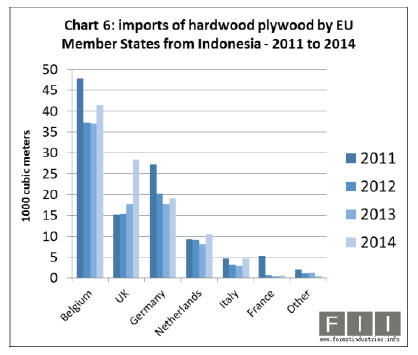
The increase in UK imports can only be partly explained
by the strong recovery in the UK construction sector. The
increase is particularly significant for a market not
traditionally known for its‟ willingness to pay higher
prices for better quality product.
For many years, Indonesian plywood was squeezed out of
the UK market by lower priced plywood from China,
Malaysia and Russia, and by other panel products.
The rise in UK imports in 2014 comes despite Indonesian
plywood prices remaining relatively firm in 2014 and also
against the background of a substantial weakening in the
value of the GBP relative to the US$.
One factor that has certainly helped boost UK and wider
EU imports from Indonesia in 2014 was the resumption of
regular break bulk services in response to volatile
container freight rates.
Indonesian plywood may also be benefitting from rising
awareness of the V-Legal/SVLK system, particularly now
that EUTR is forcing plywood importers to look more
closely at the legality of product.
Implementation of the Construction Product Regulation,
which extended mandatory requirements for CE Marking
of construction products throughout the EU, is also
increasing importers focus on species content and other
quality aspects of plywood.
Slow French market and new tariffs hit African
plywood
Trends in EU imports of hardwood plywood from African
countries varied widely in 2014 (Chart 7). Imports from
Gabon, by far the largest African supply country, declined
3% to 40,000 cu.m.
A significant proportion of this product is FSC certified
derived from large European-owned operations in Gabon.
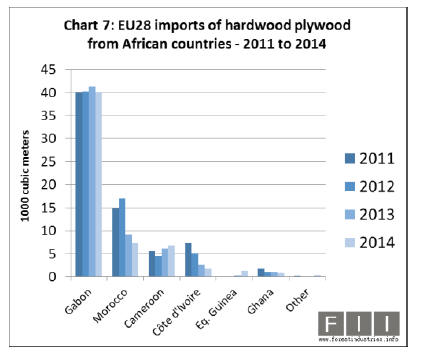
Demand was impeded by slow recovery in France,
traditionally the main European market for okoume
plywood. EU imports in 2014 were also disrupted by
occasional strikes by customs officials at Libreville port in
Gabon.
Like Malaysia, Gabon‟s GSP status changed from 1
January 2014 leading to imposition of a 7% tariff on EU
imports of hardwood plywood from Gabon.
However, under pressure from EU-based plywood
manufacturers, Gabon‟s exports of hardwood veneers to
the EU were exempt from the increase in duty. The overall
effect of the new tariff regime is to favour EU-based over
Gabon-based manufacturers.
EU imports of hardwood plywood from Morocco declined
sharply in 2014, continuing the downward trend of the
previous year.
Log export restrictions by Gabon and other countries in
the Congo region have meant that Moroccan
manufacturers now have limited access to logs. EU
imports of plywood from Cameroon have climbed in the
last two years, but were still limited at only 7000 cu.m in
2014. EU imports from Ivory Coast and Ghana were
negligible in 2014.
The majority of all African hardwood plywood imported
into the EU is now destined for just two countries每 Italy
and the Netherlands 每 with smaller volumes destined for
France, Belgium and Greece (Chart 8). European
consumption of okoume plywood has been in long term
decline, particularly in France, formerly the leading
market. Imports into France were down 40% in 2014 at
only 6000 cu.m.
However imports into Italy were relatively stable, while
there were small gains in imports by the Netherlands,
Belgium and Greece.
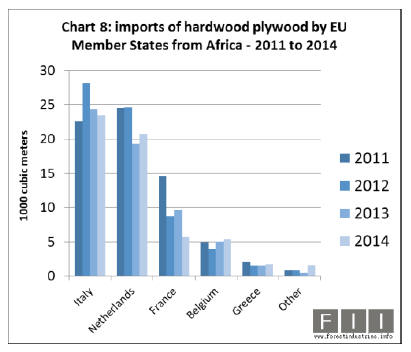
Both EU manufacturers and importers reported slightly
better demand for okoume plywood in 2014 than in the
previous year. This was driven by slow improvements in
the construction sector in the Netherlands and Belgium
and by rising boat-building activity in Italy. Sales of
okoume plywood 每 generally sold in euros unlike Asian
plywood sold in US$ 每 also benefitted from the weak euro
exchange rate during 2014.
Another advantage is relatively short delivery time. Lead
times for standard dimensions may be under 2 weeks. A
growing share of supply and demand for okoume plywood
in the EU market is FSC certified.
With extremely tight margins in the industry, okoume
plywood manufacturers were trying to push through price
increases in 2014, but struggled in the face of weak
European consumption and intense competition from
alternative products.
However, in early 2015 the market situation has been
sufficiently favourable to allow manufacturers and
distributors to push through limited price increases,
particularly for FSC certified products.
Weak rouble boosts EU imports from Russia
Total EU imports of Russian birch plywood increased
10% to 785,000 cu.m in 2014.
Unlike other imported hardwood plywood, which is sold
into a limited range of Western European countries, the
market for Russian birch products is widely distributed
across the continent (Chart 9).
In 2014, there was a particularly sharp increase in imports
of Russian birch plywood into Germany, the largest
market, and also gains in imports into Latvia, Italy,
Estonia, the UK, Poland, Netherlands and the Czech
Republic.
Of larger markets, only Finland imported a lower volume
of Russian plywood in 2014. Finland has been mired in
recession for the last three years and has a large domestic
birch plywood industry.
The price competitiveness of Russian birch plywood
increased dramatically in the second half of 2014 due to
the sharp fall in the value of the Russian rouble 每 which
plunged 40% against the euro and 50% against the US$
between July and December 2014. Supplies of Russian
birch plywood were also readily available.
In the last quarter 2014, lead times between ordering and
delivery into the EU were no more than around 4 weeks on
average. There was particularly good availability of filmed
plywood grades as domestic demand for this product in
Russia has been weakening.
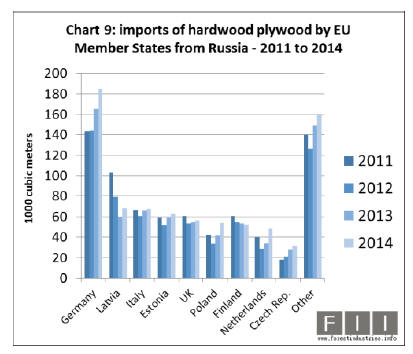
The dramatic fall in Russian birch plywood prices forced
domestic European manufacturers of this commodity to
reduce prices to boost market share. In an effort to stem
the flow of cheap product into the European market,
Russian and European birch plywood manufacturers are
now working hard to develop markets in other parts of the
world, notably in the United States, South Korea, Egypt,
and Turkey.
Increased EU imports of softwood plywood
EU imports of softwood plywood were 1.3 million cu.m
with value of €365 million in 2014, up 13% and 9%
respectively compared to the previous year (Chart 10).
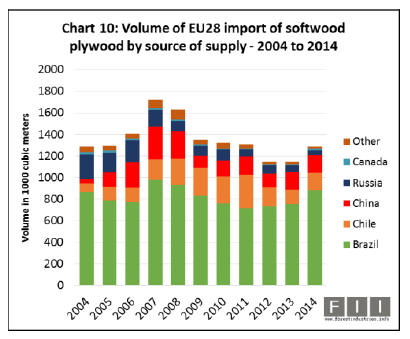
Imports from Brazil increased 17% to 883,000 cu.m in
2014. Brazil‟s share of total imports increased from 66%
in 2013 to 68% in 2014, continuing an upward trend in
share that began in 2011 (Chart 11). Imports from Chile
also increased 23% to 163,000 cu.m in 2014, recovering
from a decline in 2013.
Between 2013 and 2014 Chile‟s share of total EU imports
increased from 12% to 13%. However imports of
softwood plywood from China declined 5% to 162,000
cu.m in 2014. China‟s share of EU imports fell from 15%
to 13% during the year.
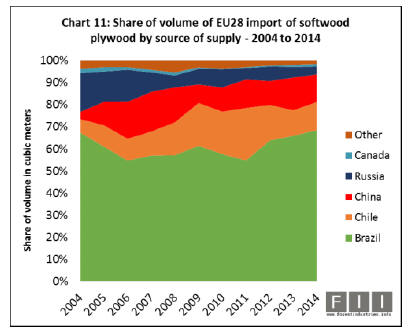
Much of the gain in EU imports was due to improving
market conditions in the UK. However imports also
increased into Belgium, Italy, Denmark and the
Netherlands in 2014. Imports into Germany were weaker
in 2014 (Chart 12).
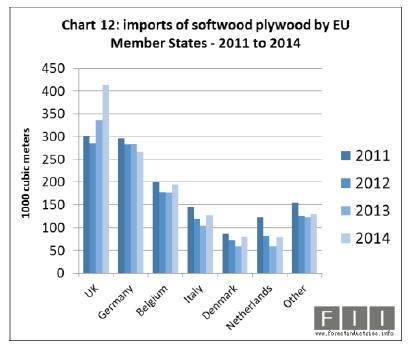
In the first half of 2014, Brazilian exporters were
constantly pushing their European buyers to pay higher
prices following appreciation of the Brazilian real
exchange rate against the dollar and with strong demand in
other export markets. Exporters also needed to cover
higher log, energy and wage costs.
These pressures eased in the second half of 2014 as the
Brazilian real once again depreciated against the dollar,
GBP and the euro.
There has also been sustained downturn in the Brazilian
domestic market. Nevertheless, export demand for
Brazilian softwood plywood has remained good in North
America, Asia and Oceania.
Chinese plywood target of EUTR enforcement
activities
Earlier this year, the UK government published a report on
EUTR enforcement measures targeting importers of
Chinese plywood. The report was prepared by the National
Measurements Office (NMO), the UK government agency
responsible for EUTR.
The report states that the focus on Chinese plywood is not
due to concerns about illegal harvesting in China. Instead
it is due to the perceived risks of China‟s high dependence
on imports and the complexity of supply chains for
plywood in China.
The NMO report summarises EUTR enforcement action
taken against 16 companies importing Chinese plywood
into the UK. All the importing companies involved are
small-to-medium enterprises (SMEs). Together they were
responsible for no more than 10% of the plywood
imported from China into the UK in the last year.
The action specifically excludes companies that have
already demonstrated due diligence to the satisfaction of
NMO. The latter includes the whole of the UK‟s largescale
timber retail sector which accounts for by far the
largest share of plywood imported into the UK.
NMO observes that ※the Chinese forestry system and
exploitation of domestic forests tend to represent a minor
risk due to strong legislation and governance as well as a
low risk to the species harvested (poplar, eucalyptus) for
plywood manufacturing§.
However, NMO also states ※a range of independent
background studies have indicated that timber imported
into China is likely to be done so illegally and therefore is
unlikely to comply with the due diligence requirements of
the EUTR§.
The NMO report highlights the challenges of due
diligence in a long and complex supply chain.
In the countries of origin for both the core and the face
veneers there can be a number of forests/plantations and a
number of harvesters supplying the constituent parts. In
turn there are a number of different suppliers to the
peeling mills and manufacturers.
The supply chain is further complicated as many UK
importers employ an agent to do most of their sourcing
and purchasing. These agents are in turn using companies
that source timber from other agents, resulting in a
complicated supply chain.
Species wrongly identified in Chinese plywood
As part of the enforcement action, the NMO performed
microscopic analysis on plywood purchased from the
importers to ascertain species content. Of the 13 purchases
tested so far, 9 products did not match the declaration
supplied by each company regarding the species contained
within the plywood.
In the 13 tested products, there were four cases in which
face veneers were wrongly identified (including sapele
misidentified as lotofa, ozigo misidentified as eucalyptus,
bintangor misidentified as eucalyptus, and palaquium
misidentified as bintangor).
There were 8 cases in which the core veneer was wrongly
identified. All of these were described as either pure
poplar or eucalyptus but in fact contained other species
(including kedongdong, pine, kasai, elm, pulai, red
meranti, and medang).
Because of supply-chain complexity and the lack of
accurate data on the actual level of risk associated with
different species and supply sources, NMO does not claim
to show that any of the timber in the plywood traded by
the 16 UK importers is from an illegal source.
The report states that "the species that are found may still
be covered by the felling licenses, phytosanitary
certificates and third-party verification certificates".
The detailed results of the species analysis suggests no
systematic attempt to misrepresent one particular species
for another. Instead it indicates a random process due to
species mixing and inadequate control in a complex
supply chain.
Having considered the evidence in more detail, NMO
concludes that "the overall risk is low in relation to the
possibility of illegal logging in the supply chain".
Proof unnecessary to prosecute under the EUTR
The NMO report also highlights a key feature of the
EUTR. Prosecution of EU operators does not require the
EU authorities to establish a credible chain of evidence to
show that timber is illegal.
The importer has a responsibility to demonstrate due
diligence in line with the risk management system
specified in the EUTR.
This includes documented steps to identify and mitigate
any risk that timber is from an illegal source before
placing the product on the EU market. The importer can be
prosecuted simply for failing to demonstrate to the EU
authorities that the risk management system is in place.
The 16 UK importers targeted for enforcement action were
requested to supply details of the due diligence system for
the Chinese plywood that they place on the market in the
EU.
The report notes that ※14 of the 16 companies submitted
due diligence systems that were insufficient when
compared to Article 6 of the European Timber Regulation
(EUTR) No. 995/2010 that outlines an Operators
obligation to implement a due diligence system§.
According to NMO, ※the common thread running through
these failures was a lack of narrative explaining how the
combination of document gathering, risk assessment and
mitigation (where necessary) enable the company to reach
a conclusion of negligible risk that the timber in the
product was sourced illegally§.
The failure to accurately identify species in product
declarations ※further indicated the unreliability of the
supply chain of these products§.
The NMO also commented that the "unreliability of
paperwork was ubiquitous, indicating that this is a clear
area for concern in due diligence procedures".
Following visits to the companies, NMO decided to take
no further action in relation to 4 companies. However 7
companies were issued with a warning letter and 5
companies were issued with a notice of remedial action.
The NMO also noted that it continues to investigate the
UK companies and that further sanctions will be applied if
companies fail to take necessary remedial action.
Implications for UK trade in Chinese plywood
The long-term implications of the NMO report are very
significant for the future of the EU trade in plywood
manufactured in China.
The report shows the determination of the NMO to ensure
that the due diligence system specified in the EUTR is
applied rigorously.
UK plywood importers are on notice that they must
accurately identify the exact species used both for face and
core veneers despite the complexity of the supply chain
and even if the underlying risks of illegal origin are small.
NMO also insist in the report that operators should always
assess the paperwork themselves and record their own risk
determination.
They cannot take certificates and other documents issued
by their overseas suppliers at face value and must assess
the broader governance environment in the region of
supply. Nor can they rely on the assessments of their
agents, certifiers or other third parties.
NMO quotes one company that suspended all supplies
from one country as they didn‟t feel they could achieve
negligible risk without investing more time and money.
The boycotting by an importer in the EU of wood products
from a developing country due the importers lack of
resources to undertake risk assessment hardly seems a
positive outcome for EUTR.
Risk assessment implies a much more rigorous approach
on the part of importers to supply chain management. The
downside is that this means higher transaction costs for the
EU trade have to be absorbed by the supply chain.
More positively, the strong focus on species content and
transparency in supply chains is an opportunity to improve
the quality and reputation of Chinese plywood in the EU
market.
NMO conclude their report: ※given there is a high overall
level of non-compliance in this particular area of the
timber trade, it is recommended that a similar project is
conducted during the next financial year, targeting other
companies, in order to monitor the progress of this sector
of the industry§.
|